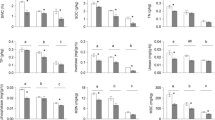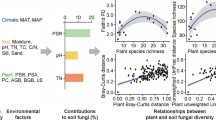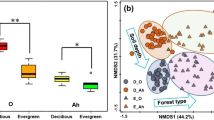Abstract
Background and aims
Revegetation with xeric shrubs is a widely applied measure for restoring degraded ecosystems in the deserts of northern China. However, knowledge on the soil fungal assemblages in revegetated shrubs still remains veiled. This study aimed to evaluate how soil fungal diversity and composition respond to shrub species.
Methods
We characterized soil fungal communities in three different shrublands (Artemisia ordosica, Salix psammophila, and Caragana microphylla), which had been planted on bare sandland for about 20 years, in the Mu Us Desert in northern China, using high-throughput 18S rRNA gene sequencing. The relationships of fungal community diversity and composition with environmental variables were explored by regression analysis and Mantel test, respectively.
Results
The dominant phyla across the studied samples were Ascomycota and Basidiomycota. Compared to bare sandland, fungal diversity was significantly greater in A. ordosica and C. microphylla but not in S. psammophila. There was a positive linear relationship between soil fungal and understory plant diversity. A. ordosica and C. microphylla shrublands showed the greatest relative abundance of Ascomycota; S. psammophila shrubland showed the greatest relative abundance of Basidiomycota. In terms of functional groups, the highest relative abundance of ectomycorrhizal fungi and the lowest relative abundance of pathogenic fungi were found in S. psammophila shrubland. Soil collected from A. ordosica shrubland showed the highest relative abundance of arbuscular mycorrhizal fungi.
Conclusions
Variations in fungal diversity and assemblages were directly affected by the revegetated shrub species. The strong correlation of the fungal community and shrubs provides a better understanding of soil organic carbon sequestration and plant–soil interaction in different revegetated shrublands.






Similar content being viewed by others
References
Averill C, Hawkes CV (2016) Ectomycorrhizal fungi slow soil carbon cycling. Ecol Lett 19:937–947. https://doi.org/10.1111/ele.12631
Averill C, Turner BL, Finzi AC (2014) Mycorrhiza-mediated competition between plants and decomposers drives soil carbon storage. Nature 505:543–545. https://doi.org/10.1038/nature12901
Baldrian P, Voříšková J, Dobiášová P, Merhautová V, Lisá L, Valášková V (2011) Production of extracellular enzymes and degradation of biopolymers by saprotrophic microfungi from the upper layers of forest soil. Plant Soil 338:111–125. https://doi.org/10.1007/s11104-010-0324-3
Baldrian P, Kolařík M, Štursová M, Kopecký J, Valášková V, Větrovský T, Žifčáková L, Šnajdr J, Rídl J, Vlček Č, Voříšková J (2012) Active and total microbial communities in forest soil are largely different and highly stratified during decomposition. ISME J 6:248–258. https://doi.org/10.1038/ismej.2011.95
Bell T, Freckleton RP, Lewis OT (2006) Plant pathogens drive density-dependent seedling mortality in a tropical tree. Ecol Lett 9:569–574. https://doi.org/10.1111/j.1461-0248.2006.00905.x
Bell TH, Hassan SED, Lauron-Moreau A, Al-Otaibi F, Hijri M, Yergeau E, St-Arnaud M (2014) Linkage between bacterial and fungal rhizosphere communities in hydrocarbon-contaminated soils is related to plant phylogeny. ISME J 8:331–343. https://doi.org/10.1038/ismej.2013.149
Belnap J, Welter JR, Grimm NB, Barger N, Ludwig JA (2005) Linkages between microbial and hydrologic processes in arid and semiarid watersheds. Ecology 86:298–307. https://doi.org/10.1890/03-0567
Berg G, Smalla K (2009) Plant species and soil type cooperatively shape the structure and function of microbial communities in the rhizosphere. FEMS Microbiol Ecol 68:1–13. https://doi.org/10.1111/j.1574-6941.2009.00654.x
Bever JD, Mangan SA, Alexander HM (2015) Maintenance of plant species diversity by pathogens. Annu Rev Ecol Syst 46:305–325. https://doi.org/10.1146/annurev-ecolsys-112414-054306
Blackwood CB, Waldrop MP, Zak DR, Sinsabaugh RL (2007) Molecular analysis of fungal communities and laccase genes in decomposing litter reveals differences among forest types but no impact of nitrogen deposition. Environ Microbiol 9:1306–1316. https://doi.org/10.1111/j.1462-2920.2007.01250.x
Bödeker I, Lindahl BD, Olson Å, Clemmensen KE (2016) Mycorrhizal and saprotrophic fungal guilds compete for the same organic substrates but affect decomposition differently. Funct Ecol 30:1967–1978. https://doi.org/10.1111/1365-2435.12677
Boisvenue C, Running SW (2006) Impacts of climate change on natural forest productivity–evidence since the middle of the 20th century. Glob Chang Biol 12:862–882. https://doi.org/10.1111/j.1365-2486.2006.01134.x
Clemmensen KE, Finlay RD, Dahlberg A, Stenlid J, Wardle DA, Lindahl BD (2015) Carbon sequestration is related to mycorrhizal fungal community shifts during long-term succession in boreal forests. New Phytol 205:1525–1536. https://doi.org/10.1111/nph.13208
Cline LC, Hobbie SE, Madritch MD, Buyarski CR, Tilman D, Cavender-Bares JM (2018) Resource availability underlies the plant-fungal diversity relationship in a grassland ecosystem. Ecology 99:204–216. https://doi.org/10.1002/ecy.2075
Cotrufo MF, Wallenstein MD, Boot CM, Denef K, Paul E (2013) The microbial efficiency-matrix stabilization (MEMS) framework integrates plant litter decomposition with soil organic matter stabilization: do labile plant inputs form stable soil organic matter? Glob Chang Biol 19:988–995. https://doi.org/10.1111/gcb.12113
Delgado-Baquerizo M, Maestre FT, Reich PB, Jeffries TC, Gaitan JJ, Encinar D, Berdugo M, Campbell CD, Singh BK (2016) Microbial diversity drives multifunctionality in terrestrial ecosystems. Nat Commun 7:10541. https://doi.org/10.1038/ncomms10541
Dickie IA (2007) Host preference, niches and fungal diversity. New Phytol 174:230–233. https://doi.org/10.1111/j.1469-8137.2007.02055.x
Edgar RC (2010) Search and clustering orders of magnitude faster than BLAST. Bioinformatics 26:2460–2461. https://doi.org/10.1093/bioinformatics/btq461
Edgar RC, Haas BJ, Clemente JC, Quince C, Knight R (2011) UCHIME improves sensitivity and speed of chimera detection. Bioinformatics 27:2194–2200. https://doi.org/10.1093/bioinformatics/btr381
Gao C, Shi NN, Chen L, Ji NN, Wu BW, Wang YL, Xu Y, Zheng Y, Mi XC, Ma KP, Guo LD (2016) Relationships between soil fungal and woody plant assemblages differ between ridge and valley habitats in a subtropical mountain forest. New Phytol 213:1874–1885. https://doi.org/10.1111/nph.14287
Goldmann K, Schöning I, Buscot F, Wubet T (2015) Forest management type influences diversity and community composition of soil fungi across temperate forest ecosystems. Front Microbiol 6:1300. https://doi.org/10.3389/fmicb.2015.01300
Gömöryová E, Ujházy K, Martinák M, Gömöry D (2013) Soil microbial community response to variation in vegetation and abiotic environment in a temperate old-growth forest. Appl Soil Ecol 68:10–19. https://doi.org/10.1016/j.apsoil.2013.03.005
Hector A, Bagchi R (2007) Biodiversity and ecosystem multifunctionality. Nature 448:188–190. https://doi.org/10.1038/nature05947
Herman DJ, Firestone MK, Nuccio E, Hodge A (2012) Interactions between an arbuscular mycorrhizal fungus and a soil microbial community mediating litter decomposition. FEMS Microbiol Ecol 80:236–247. https://doi.org/10.1111/j.1574-6941.2011.01292.x
Hiiesalu I, Pärtel M, Davison J, Gerhold P, Metsis M, Moora M, Öpik M, Vasar M, Zobel M, Wilson SD (2014) Species richness of arbuscular mycorrhizal fungi: associations with grassland plant richness and biomass. New Phytol 203:233–244. https://doi.org/10.1111/nph.12765
Jia X, Zha TS, Wu B, Zhang YQ, Gong JN, Qing SG, Chen GP, Qian D, Kellomäki S, Peltola H (2014) Biophysical controls on net ecosystem CO2 exchange over a semiarid shrubland in Northwest China. Biogeosciences 11:4679–4693. https://doi.org/10.5194/bg-11-4679-2014
Koorem K, Tulva I, Davison J, Jairus T, Öpik M, Vasar M, Zobel M, Moora M (2017) Arbuscular mycorrhizal fungal communities in forest plant roots are simultaneously shaped by host characteristics and canopy-mediated light availability. Plant Soil 410:259–271. https://doi.org/10.1007/s11104-016-3004-0
Kozich JJ, Westcott SL, Baxter NT, Highlander SK, Schloss PD (2013) Development of a dual-index sequencing strategy and curation pipeline for analyzing amplicon sequence data on the MiSeq Illumina sequencing platform. Appl Environ Microbiol 79:5112–5120. https://doi.org/10.1128/AEM.01043-13
Lai ZR, Zhang YQ, Wu B, Zha TS, Qin SG, Jia X, Liu JB, Feng W (2014) Fine root distribution and belowground interactions in an alley silvopasture system in northern China. Turk Agric For 38:644–651. https://doi.org/10.3906/tar-1401-10
Lai ZR, Zhang YQ, Liu JB, Wu B, Qin SG, Fa KY (2016) Fine-root distribution, production, decomposition, and effect on soil organic carbon of three revegetation shrub species in Northwest China. Forest Ecol Manag 359:381–388. https://doi.org/10.1016/j.foreco.2015.04.025
Lai ZR, Liu JB, Zhang YQ, Wu B, Qin SG, Sun YF, Zhang JT, Feng W, Fa KY, Bai YX (2017) Introducing a shrub species in a degraded steppe shifts fine root dynamics and soil organic carbon accumulations, in Northwest China. Ecol Eng 100:277–285. https://doi.org/10.1016/j.ecoleng.2017.01.001
LeBlanc N, Kinkel LL, Kistler HC (2015) Soil fungal communities respond to grassland plant community richness and soil edaphics. Microb Ecol 70:188–195. https://doi.org/10.1007/s00248-014-0531-1
Li HY, Smith SE, Holloway RE, Zhou YG, Smith FA (2006) Arbuscular mycorrhizal fungi contribute to phosphorus uptake by wheat grown in a phosphorus-fixing soil even in the absence of positive growth responses. New Phytol 172:536–543. https://doi.org/10.1111/j.1469-8137.2006.01846.x
Li XG, Ding CF, Zhang TL, Wang XX (2014) Fungal pathogen accumulation at the expense of plant-beneficial fungi as a consequence of consecutive peanut monoculturing. Soil Biol Biochem 72:11–18. https://doi.org/10.1016/j.soilbio.2014.01.019
Lindahl BD, Tunlid A (2015) Ectomycorrhizal fungi–potential organic matter decomposers, yet not saprotrophs. New Phytol 205:1443–1447. https://doi.org/10.1111/nph.13201
Liu JJ, Sui YY, Yu ZH, Shi Y, Chu HY, Jia J, Liu XB, Wang GH (2015) Soil carbon content drives the biogeographical distribution of fungal communities in the black soil zone of Northeast China. Soil Biol Biochem 83:29–39. https://doi.org/10.1016/j.soilbio.2015.01.009
Magoč T, Salzberg SL (2011) FLASH: fast length adjustment of short reads to improve genome assemblies. Bioinformatics 27:957–2963. https://doi.org/10.1093/bioinformatics/btr507
Makhalanyane TP, Valverde A, Gunnigle E, Frossard A, Ramond J, Cowan DA (2015) Microbial ecology of hot desert edaphic systems. FEMS Microbiol Rev 39:203–221. https://doi.org/10.1093/femsre/fuu011
Martínez-García LB, Richardson SJ, Tylianakis JM, Peltzer DA, Dickie IA (2015) Host identity is a dominant driver of mycorrhizal fungal community composition during ecosystem development. New Phytol 205:1565–1576. https://doi.org/10.1111/nph.13226
Merilä P, Malmivaara-Lämsä M, Spetz P, Stark S, Vierikko K, Derome J, Fritze H (2010) Soil organic matter quality as a link between microbial community structure and vegetation composition along a successional gradient in a boreal forest. Appl Soil Ecol 46:259–267. https://doi.org/10.1016/j.apsoil.2010.08.003
Mölder A, Streit M, Schmidt W (2014) When beech strikes back: how strict nature conservation reduces herb-layer diversity and productivity in central European deciduous forests. Forest Ecol Manag 319:51–61. https://doi.org/10.1016/j.foreco.2014.01.049
Öpik M, Moora M, Liira J, Zobel M (2006) Composition of root-colonizing arbuscular mycorrhizal fungal communities in different ecosystems around the globe. J Ecol 94:778–790. https://doi.org/10.1111/j.1365-2745.2006.01136.x
Peay KG, Baraloto C, Fine PVA (2013) Strong coupling of plant and fungal community structure across western Amazonian rainforests. ISME J 7:1852–1861. https://doi.org/10.1038/ismej.2013.66
Petermann JS, Fergus AJF, Turnbull LA, Schmid B (2008) Janzen-Connell effects are widespread and strong enough to maintain diversity in grasslands. Ecology 89:2399–2406. https://doi.org/10.1890/07-2056.1
Pugnaire FI, Armas C, Valladares F (2004) Soil as a mediator in plant-plant interactions in a semi-arid community. J Veg Sci 15:85–92. https://doi.org/10.1658/1100-9233(2004)015[0085:SAAMIP]2.0.CO;2
Schmidt SK, Nemergut DR, Darcy JL, Lynch R (2014) Do bacterial and fungal communities assemble differently during primary succession? Mol Ecol 23:254–258. https://doi.org/10.1111/mec.12589
Soudzilovskaia NA, van der Heijden MGA, Cornelissen JHC, Makarov MI, Onipchenko VG, Maslov MN, Akhmetzhanova AA, van Bodegom PM (2015) Quantitative assessment of the differential impacts of arbuscular and ectomycorrhiza on soil carbon cycling. New Phytol 208:280–293. https://doi.org/10.1111/nph.13447
Sterkenburg E, Bahr A, Brandström Durling M, Clemmensen KE, Lindahl BD (2015) Changes in fungal communities along a boreal forest soil fertility gradient. New Phytol 207:1145–1158. https://doi.org/10.1111/nph.13426
Tedersoo L, Bahram M, Põlme S, Kõljalg U, Yorou NS et al (2014) Global diversity and geography of soil fungi. Science 346:1256688. https://doi.org/10.1126/science.1256688
Tedersoo L, Bahram M, Cajthaml T, Põlme S, Hiiesalu I, Anslan S, Harend H, Buegger F, Pritsch K, Koricheva J, Abarenkov K (2016) Tree diversity and species identity effects on soil fungi, protists and animals are context dependent. ISME J 10:346–362. https://doi.org/10.1038/ismej.2015.116
Urbanová M, Šnajdr J, Baldrian P (2015) Composition of fungal and bacterial communities in forest litter and soil is largely determined by dominant trees. Soil Biol Biochem 84:53–64. https://doi.org/10.1016/j.soilbio.2015.02.011
Van Der Heijden MGA, Bardgett RD, Van Straalen NM (2008) The unseen majority: soil microbes as drivers of plant diversity and productivity in terrestrial ecosystems. Ecol Lett 11:296–310. https://doi.org/10.1111/j.1461-0248.2007.01139.x
Vargas-Gastélum L, Romero-Olivares AL, Escalante AE, Rocha-Olivares A, Brizuela C, Riquelme M (2015) Impact of seasonal changes on fungal diversity of a semi-arid ecosystem revealed by 454 pyrosequencing. FEMS Microbiol Ecol 91:fiv044. https://doi.org/10.1093/femsec/fiv044
Waldrop MP, Zak DR, Blackwood CB, Curtis CD, Tilman D (2006) Resource availability controls fungal diversity across a plant diversity gradient. Ecol Lett 9:1127–1135. https://doi.org/10.1111/j.1461-0248.2006.00965.x
Wang B, Xue S, Liu GB, Zhang GH, Li G, Ren ZP (2012) Changes in soil nutrient and enzyme activities under different vegetations in the loess plateau area, Northwest China. Catena 92:186–195. https://doi.org/10.1016/j.catena.2011.12.004
Wang JT, Zheng YM, Hu HW, Zhang LM, Li J, He JZ (2015) Soil pH determines the alpha diversity but not beta diversity of soil fungal community along altitude in a typical Tibetan forest ecosystem. J Soils Sediments 15:1224–1232. https://doi.org/10.1007/s11368-015-1070-1
Wang SK, Zuo XA, Zhao XY, Li YQ, Zhou X, Lv P, Luo YQ, Yun JY (2016a) Responses of soil fungal community to the sandy grassland restoration in Horqin sandy land, northern China. Environ Monit Assess 188:21. https://doi.org/10.1007/s10661-015-5031-3
Wang ZT, Chen Q, Liu L, Wen X, Liao YC (2016b) Responses of soil fungi to 5-year conservation tillage treatments in the drylands of northern China. Appl Soil Ecol 101:132–140. https://doi.org/10.1016/j.apsoil.2016.02.002
Wardle DA, Lindahl BD (2014) Disentangling global soil fungal diversity. Science 346:1052–1053. https://doi.org/10.1126/science.aaa1185
Zavaleta ES, Pasari JR, Hulvey KB, Tilman GD (2010) Sustaining multiple ecosystem functions in grassland communities requires higher biodiversity. P Natl Acad Sci USA 107:1443–1446. https://doi.org/10.1073/pnas.0906829107
Zuo XA, Wang SK, Lv P, Zhou X, Zhao XY, Zhang TH, Zhang J (2016) Plant functional diversity enhances associations of soil fungal diversity with vegetation and soil in the restoration of semiarid sandy grassland. Ecol Evol 6:318–328. https://doi.org/10.1002/ece3.1875
Acknowledgments
This study was supported by the National Key Research and Development Program of China (no. 2016YFC0500905), the National Natural Science Foundation of China (no. 31470711), and the Fundamental Research Funds for the Central Universities (no. 2015ZCQ-SB-02). We would like to thank the staff of the Yanchi Research Station. Special thanks to Weiwei She, Jun Liu, and Li Wang for their help with sampling and measurements in the field and laboratory.
Author information
Authors and Affiliations
Corresponding author
Additional information
Responsible Editor: Timothy Cavagnaro.
Electronic supplementary material
Fig. S1
Distribution of the bare sandland and the three shrubland in the study area. Aro, Artemisia ordosica; Sap, Salix psammophila; Cam, Caragana microphylla (PNG 12044 kb)
Fig. S2
Soil sampling schematic diagram in each plot of the bare sandland. “X” is the sampling site. (PNG 30 kb)
Fig. S3
Relationships between soil properties and fungal diversity (n = 3). SWC, soil water content; SOC, soil organic carbon; TN, total nitrogen; TP, total phosphorus (PNG 590 kb)
Table S1
(XLSX 36 kb)
Table S2
(DOCX 16 kb)
Table S3
(DOCX 14 kb)
Rights and permissions
About this article
Cite this article
Sun, Y., Zhang, Y., Feng, W. et al. Revegetated shrub species recruit different soil fungal assemblages in a desert ecosystem. Plant Soil 435, 81–93 (2019). https://doi.org/10.1007/s11104-018-3877-1
Received:
Accepted:
Published:
Issue Date:
DOI: https://doi.org/10.1007/s11104-018-3877-1




